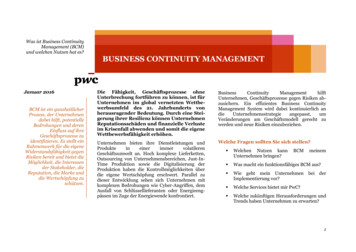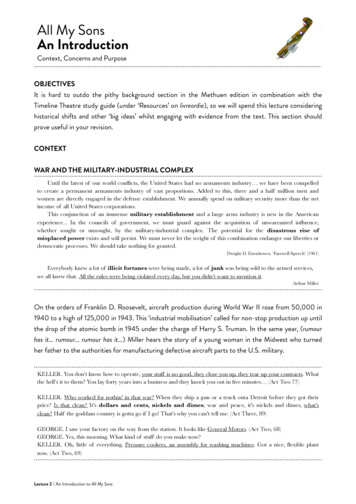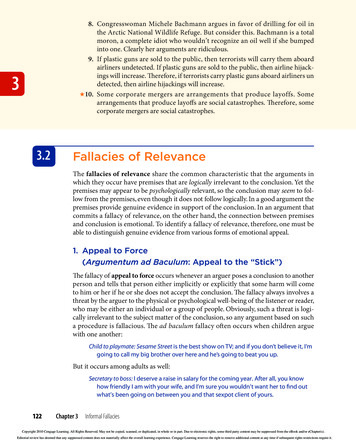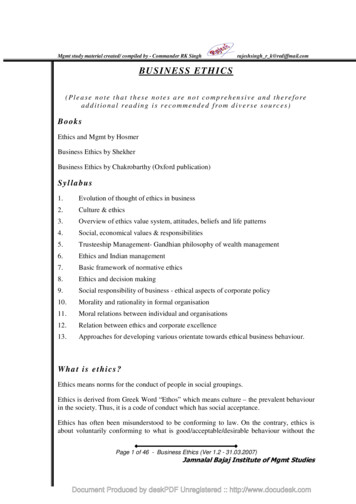
Transcription
Introduction to BusinessManagementC COBU211
Compiled by Pierre DietrichsenQuality assured by Mariet DuvenhageEdited by Carol FofoVersion 2.0NQF Level 5Credit value 12 January 2016 CTI EDUCATION GROUP
TABLE OF CONTENTSINTRODUCTION . 1MODULE AIM. 1MODULE DESCRIPTION . 1LEARNING OUTCOMES AND ASSESSMENT CRITERIA . 2INFORMATION RESOURCES. 4Prescribed e-book . 4Recommended information sources. 4USING THE STUDY GUIDE . 4Structure . 5Glossary . 5Individual units . 5The use of icons . 6Alignment to prescribed e-book . 8CONCLUDING REMARKS . 9UNIT 1:1.11.21.31.41.5INTRODUCTION .TYPES OF BUSINESSES .ORGANISATIONAL PURPOSES OF BUSINESS .RESPONSIBILITIES OF THE BUSINESS .CONCLUDING REMARKS .UNIT 5.55.623232526282930ROLES AND QUALITIES OF MANAGERS. 33INTRODUCTION .TYPES OF MANAGERS .MANAGERIAL ROLES .MANAGEMENT AND COMPETITIVE ADVANTAGE .MANAGERIAL COMPETENCE .CHALLENGES OF THE NEW MANAGER.CONCLUDING REMARKS .UNIT 5:1718192021THE NATURE OF MANAGEMENT . 23INTRODUCTION .THE HISTORICAL CONTEXT .TRADITIONAL APPROACHES TO MANAGEMENT .CONTEMPORARY APPROACHES TO MANAGEMENT .THE IMPORTANCE OF MANAGEMENT .ORGANISATIONAL BEHAVIOUR AND MANAGEMENT .CONCLUDING REMARKS .UNIT 4:1112131416ENTREPRENEURSHIP AND THE SMALL BUSINESS. 17INTRODUCTION .THE NATURE OF ENTREPRENEURSHIP .SMALL BUSINESS .CORPORATIONS AND SMALL BUSINESSES .CONCLUDING REMARKS .UNIT 3:3.13.23.33.43.53.63.7THE NATURE OF ORGANISATIONS AND BUSINESSES . 1133333536373839PLANNING AS A MANAGEMENT TASK . 43INTRODUCTION .ORGANISATIONAL STRATEGY .PLANNING AS A MANAGEMENT TASK .THE PLANNING PROCESS .THE INTERRELATIONSHIP OF TASKS.DECISION-MAKING AND PLANNING .434345464647
5.7CONCLUDING REMARKS . 48UNIT 6:6.16.26.36.46.56.6INTRODUCTION .THE NATURE OF ORGANISING .ORGANISATIONAL DESIGN .ORGANISATIONAL STRUCTURE.THE NATURE OF CONTROL AS A MANAGEMENT TASK .CONCLUDING REMARKS .UNIT UNCTIONS OF BUSINESS . 73INTRODUCTION .THE KEY FUNCTIONS OF BUSINESS .INTEGRATING FUNCTIONS AND THEIR INTERRELATIONSHIP .MANAGING THE BUSINESS OPERATION .CONCLUDING REMARKS .UNIT 10:596061626364DIMENSIONS AND ENVIRONMENTS OF BUSINESS . 67INTRODUCTION .THE ENTERPRISE .NON-GOVERNMENTAL ORGANISATIONS .THE BUSINESS ENVIRONMENT .CONCLUDING REMARKS .UNIT 9:494951525456LEADING AS A MANAGEMENT TASK . 59INTRODUCTION .DIMENSIONS OF LEADING .Motivation .Communication .DEVELOPING LEADERSHIP POTENTIAL .CONCLUDING REMARKS .UNIT 8:8.18.28.38.48.5ORGANISING AND CONTROL AS MANAGEMENT TASKS . 497374767879GOVERNANCE, COMPLIANCE AND SUSTAINABILITY . 8110.1 INTRODUCTION .10.2 THE REGULATORY ENVIRONMENT .10.3 CORPORATE SOCIAL RESPONSIBILITY .10.4 CONTEMPORARY CSR ISSUES IN SOUTH AFRICA .10.5 SUSTAINABILITY AND ECOLOGY .10.5.1 Sustainability .10.5.2 Ecology .10.5.3 The Green Movement .10.6 CONCLUDING REMARKS .818284868787878889GLOSSARY. 91BIBLIOGRAPHY . 95
IntroductionPage 1IntroductionWelcome to Introduction to Business Management. The main sources ofinformation for the module are a prescribed e-book and a Study Guide. TheStudy Guide should not be seen as a replacement for the prescribed e-book.You must use it in conjunction with the e-book, which contains the actuallearning content of the module. You are expected to work independentlythrough the relevant sections of the e-book. The Study Guide facilitates thisprocess by means of references to relevant sections in the e-book.In this introductory unit, we provide you with the following information onIntroduction to Business Management: A brief description of the moduleThe learning outcomes and assessment criteria involved in the moduleAn outline of the module structureAn explanation of the purpose, design and the proper use of the StudyGuide and the e-bookModule aimThe primary aim of Business Management is to introduce students to thefundamentals of business and key management practices in organisations andbusiness enterprises. The concept of business management refers to theactivities that a manager needs to undertake to operate a business enterprisesuccessfully. The module provides students with essential information andskills to understand and engage in management activities and business.Module descriptionModern businesses are facing numerous challenges, ranging from globalisationof the marketplace to intense competition, the digitisation of technologies andcomplex regulatory environments. Managers have to strive to maximiseprofits, in order to keep shareholders happy, while, at the same time,considering the long-term interests of the company, so as to ensure positivefuture survival prospects. There are also external stakeholders, such ascommunities and regulatory bodies in government, which need to be satisfiedwith the policies and practices of the firm.This module, which prepares the student for other modules, introducesbusiness processes and functional areas in the business to familiarise thestudent with the operational dimensions for which managers are responsible.The core elements of a business are: marketing of products and services;financing operations and expansion; appointing suitable members of staff andproducing what the market wants. CTI EDUCATION GROUP
IntroductionPage 2The tasks, roles and responsibilities of managers will receive attention, whichwill enhance an understanding of management in the generic sense of theconcept – i.e. also in non-business organisations – with the focus on themanagement of business enterprises. These essential management tasksinclude the planning the allocation of resources, organising people to performwork, leading and motivating staff, quality control and performance control.A range of issues and challenges faced by managers also form part of thecontent of Introduction to Business Management. Day-to-day operationalissues – such as communication, government regulatory compliance,improving the quality of products and services – are key concerns of allmanagers. From a management perspective, other important issues include:managing growth, formulating and conveying the business vision to fellowmanagers and to employees, training, maintaining, motivating and retainingemployees, managing customer services and customer relationships, reducingoperational costs and communicating with suppliers.A shortage of key people in a business means that individual employees havenumerous responsibilities and they are expected to handle a wide spectrum offunctions for which they may not have the required expertise or time. Timemanagement then becomes a critical factor of day-to-day business operations.The module also highlights the situation in small enterprises. The major issueaffecting small businesses, in particular, is that of limited resources such asfinance, people and time. Small businesses also face other
Welcome to Introduction to Business Management. The main sources of information for the module are a prescribed e-book and a Study Guide. The Study Guide should not be seen as a replacement for the prescribed e-book. You must use it in conjunction with the e-book, which contains the actual learning content of the module. You are expected to work independently through the relevant sections of .File Size: 1MBPage Count: 101People also search forintro to business gasper book pdfintroduction to business management text introduction to business pdfintroduction to business book pdfintroduction to business marketing t pdfintro to business management text book











